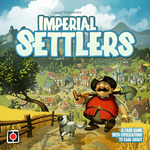 This past August I was fortunate enough to be able to attend my very first Gen Con. Although I only went for one day, that day was jam-packed with gaming goodness. For any true modern board gamer, one day is definitely not enough time to see and do everything you’d want at America’s largest board gaming convention. As much fun as I had at the convention, however, the highlight of Gen Con week for me personally, was having the opportunity to meet one of today’s premier board game designers: Ignacy Trzewiczek (Neuroshima Hex!, 51st State, and Robinson Crusoe). He and his wife Merry were visiting the Chicago area the weekend before Gen Con, and we were treated to a learning session with Ignacy’s latest game creation: Imperial Settlers. The game made its worldwide debut at Gen Con this year and sold out in just 26 minutes due to the buzz about the game. Now that I’ve been able to play it several times since then, I wanted to explain how the game plays, and give my thoughts about it.
This past August I was fortunate enough to be able to attend my very first Gen Con. Although I only went for one day, that day was jam-packed with gaming goodness. For any true modern board gamer, one day is definitely not enough time to see and do everything you’d want at America’s largest board gaming convention. As much fun as I had at the convention, however, the highlight of Gen Con week for me personally, was having the opportunity to meet one of today’s premier board game designers: Ignacy Trzewiczek (Neuroshima Hex!, 51st State, and Robinson Crusoe). He and his wife Merry were visiting the Chicago area the weekend before Gen Con, and we were treated to a learning session with Ignacy’s latest game creation: Imperial Settlers. The game made its worldwide debut at Gen Con this year and sold out in just 26 minutes due to the buzz about the game. Now that I’ve been able to play it several times since then, I wanted to explain how the game plays, and give my thoughts about it.
Imperial Settlers is a card drafting/hand management game, designed by Ignacy Trzewiczek. It plays 1 to 4 players and plays in about 45-90 minutes.
Game Overview:
In Imperial Settlers, players take control of one of four factions (Romans, Barbarians, Egyptians and Japanese) and attempt to build and expand their empire to be the most powerful and successful. This is done through the skillful use of the game’s cards, which can be used in multiple ways. Each player has his own deck of cards that are unique to his faction, and in addition, there is a large deck of “common” cards which are used by all players. During the game they will be exploring new lands, gaining and using resources, constructing and razing buildings, making deals, and sometimes attacking their enemies, all with the ultimate goal of earning the most victory points to win the game.
Game Components:
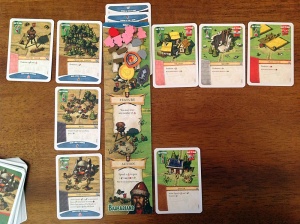
Imperial Settlers is a card game in essence, so it’s no surprise that the main components are cards, lots and lots of cards. As mentioned earlier, each player has their own deck of 30 Faction cards. The Common deck consists of 84 cards. (There are some additional Attack cards which are only used in the solo game.) Cards are all structured in basically the same way: they show the cost in resources to build the location, the location name, victory points earned at the end of the game, and a color bar in the bottom corner to identify possible benefits from other cards. All of the cards can be divided into 3 main groups: Production, Features, and Actions, and the main text section of the card identifies its group, as well as listing the resources gained (Production), benefits earned for meeting certain requirements (Features) or what special actions can be taken (Actions). In addition, the Common cards (and Japanese Faction cards) show which resources can be gained when a card is “razed”. The card stock is decent quality but since they see a lot of handling during a game, it might be advisable to sleeve them, if you’re that kind of gamer.
Players will each get a Faction board used as a “base” for their empire and the played cards will be placed alongside it. The board also contains reference information on some of the actions that can be taken in the game phases, and can also be used as a place to store the resource tokens gained on each turn. Speaking of resources, there are tokens representing Wood, Stone, Food, Defense, Razing, and Gold (which can be used as a “wild” resource in place of wood, stone or food). A supply of pink wooden meeples represent the players’ Workers. There is a Score Board, with tokens for tracking the players’ scores and the current round. Lastly, there is a First Player Marker, and some tokens specific for use with the Egyptian faction. Overall, the cardboard components are very good quality, thick enough to stand up to many, many plays. The wooden resource bits are appropriately shaped, which is always more enjoyable to play with than simple wooden cubes.
How to Play:
To setup the game, each player selects a Faction to play, takes the corresponding Faction deck and board, draws 2 Common cards, and then 2 cards from their own Faction deck as their starting hands. The game is played in 5 rounds of 4 phases each.
In the Lookout Phase, players draw another Faction card, and then a quick card selection is performed where each player will receive another 2 Common cards. The second phase is the Production Phase, and all players will gain the various resources, gold, workers, Victory Points, and/or cards that are listed in the Production section of their Faction board, any previously played Production location cards, and any goods generated by previously made Deals (more about that in the next section). The Action Phase is next, in which players will take turns playing one of 5 available actions (or passes), continuing clockwise until all player have passed. Lastly, in the Cleanup Phase, all players discard all of their used and unused workers, resources, tokens and gold. You read that correctly; anything earned by a player during the round and not used, is lost at the end of the round. The only exception to this is that each faction is allowed to store all of one type of good on their Faction board, depending on what is specified there. After that, the Round marker is moved ahead one space on the Score Board, and the next round begins.
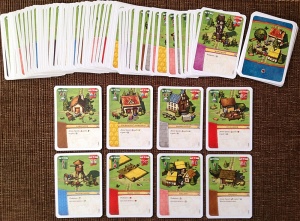
The main phase of the game is the Action phase, and the available actions are as follows:
• Building a Location: This action lets a player build a Common or Faction location card from their hand to their playing area. The cost to build a Common location requires resources, but many of the Faction locations also require the player to discard one of his previously-built locations (or a Foundation, if a location has been razed) in order to build it. A Production location lets the player immediately earn the goods listed on it, and will continue to do so in each upcoming round. A Feature location will earn benefits for the player as soon as its requirement is met (which may even be at the time of building). An Action location may be activated starting on a player’s next turn.
• Making a Deal: Instead of using a card as a built location, a player may “make a deal” with one of his Faction cards. To do this, he pays 1 Food, and then tucks the chosen card under the top edge of his Faction board, keeping the Deal area of the card visible. From now on (and immediately), the player will earn the good the Deal specifies during the upcoming Production phases.
• Razing: The Raze action lets a player either: a) raze (discard) a Common card from his hand in order to immediately gain some goods, or b) raze a Common location (or a Japanese Faction location) of another player. Razing a card from your own hand costs 1 raze token. When razing an opponent’s location, it costs 2 raze tokens (or 3 if a player has placed his Defense token on the location), and the opponent flips over his razed location, turning it into a Foundation. He loses whatever benefits the location was providing and gains 1 wood token.
• Activate an Action Location: If a player wishes to use the ability of one of his Action locations, he pays the required goods (placing them on the card to signify that the location’s action has been used), and performs the action. Unless a card says otherwise, a location’s action can only be activated once per round.
• Convert Workers to other Goods: This action allows a player to trade in 2 of his workers for any 1 resource of his choice, or 1 card (either Common or Faction). A player may exchange any number of worker pairs on a turn as he desires.
After 5 rounds of play, the final scores are calculated. In addition to Victory Points earned during the game, each location in a player’s Empire is worth either 1 (Common) or 2 (Faction) Victory Points. As you might expect, the player with the most Victory Points is the winner.
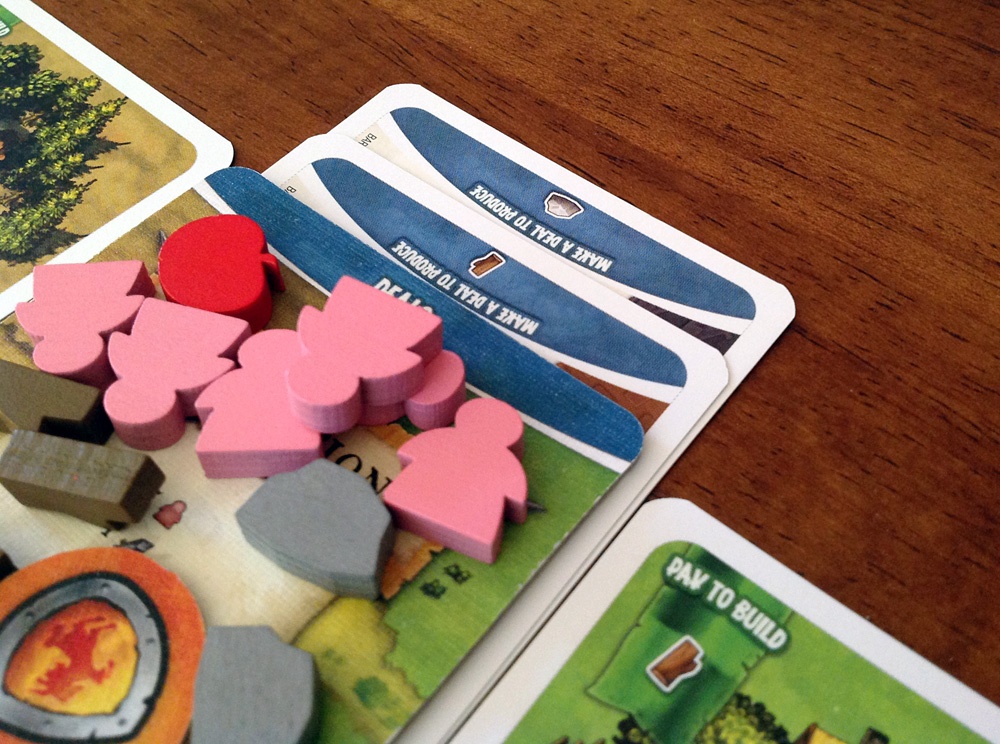
Game Experience:
As soon as I started the opening round of my first play through of Imperial Settlers, I knew I was in for something special. One of my favorite game mechanics is cards with multiple uses, and this game doesn’t disappoint in that area. Each card can be used in at least 2 or 3 ways: as a Location, to expand your Empire; as a Deal, which provides a good in every Production round; or as a Razed card, in order to gain some immediate goods. Additionally, the Locations themselves are of 3 different types: Production, Feature, or Action. This presents the player with a lot to think about right from the start of the game. Should you use a card as its location, which costs resources, but can provide benefits throughout the game? Or should you use it as a deal or raze it, which gives various goods both now and later, but at the expense of having to give up the Location use of the card? Also, since most Faction locations require the player give up an already-built a Common location as part of its cost, you’ve got to plan ahead by getting some Common locations to the table, if you want to build any (usually more powerful) Faction locations later.
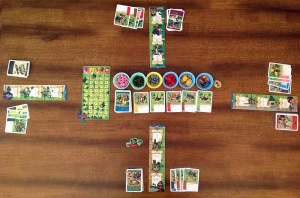
Resource maintenance is a critical aspect of this game (as it should be in a game of this type). Since each faction varies in the base goods it produces, you’ll need to find ways to produce those goods your faction is lacking in, either by Deals, Production locations, or Action locations that earn goods. However, you’ll need to balance those produced goods, because you’ll be discarding any that are unused each round. I find this to be a great little twist on the usual resource production mechanic, and adds one more element to the strategic thinking needed during the game. In one of my games, I was playing the Japanese faction, and since I could store any amount of food, I played a few cards as Deals to provide food, as well as adding a couple food Production locations. I was flush with food! However, having all that food wasn’t the godsend I thought it would be. I just wasn’t able to effectively use all that food, so it would up being sort of a waste.
In any type of hand management / variable card powers / civ building game such as this, creating at least one good engine is crucial. Therefore, it helps to know what the strengths and weaknesses of each faction are. After playing several games, here’s what I’ve noticed:
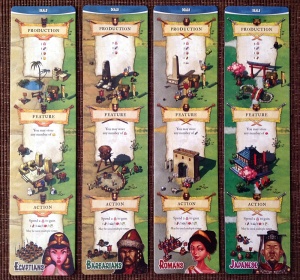
• The Roman faction produces a small amount of almost all goods, but they can store Raze tokens. This makes them very confrontational. Make sure to keep a Defense token on your most valuable location at all times, especially when playing against the Roman faction. Romans also have a lot of faction locations the work well together to score victory points.
• The Barbarian faction is worker heavy, and can store the workers it generates from round to round. Many of their faction cards utilize the raze action in one way or another, and/or directly take things from their opponents.
• The Egyptian faction can store gold on their faction board, which can make them flexible in their building, since gold is a “wild” resource. Their faction deck contains a lot of locations that earn victory points in various ways.
• Lastly, the Japanese faction is somewhat strong in worker generation (though not quite as strong as the Barbarians). They can store food, which can help them make more deals, to strengthen their goods production. Many of the locations in Japanese faction deck take advantage of the deal action, which works well with their food-storing ability. Of special note with the Japanese faction: they do have one noticeable weakness in that almost all of their faction locations can be razed. However, they also have the unique ability to be able to place workers on their locations as Samurai, which act as defense tokens that increase the amount of raze tokens needed to destroy that location.
With a game containing so many cards having so many different powers, it might be easy to pick out a handful of them and cry “Unbalanced!” I don’t feel that way, though. Overall, the game seems to be as balanced as it can be. Obviously, if a certain card comes out at just the right time under just the right circumstances, it has the potential to be more powerful than those around it. But there is always luck involved in card draws, as there is in any other game of this type, and I think that luck factor helps to mitigate any issues that might arise with some of the “power” cards. If I had to point out anything negative about this game (and I almost hate to do it), it might be that the text on the cards could probably have been made a little larger. As long as I’m wearing my reading glasses, it’s almost never a problem for me to read game components in general. However, I’ve noticed that I really struggle with the cards in this game. I’ve read that other people are having trouble with the small type on the cards as well, so it’s not just me. In some situations, it can be frustrating, and might lessen someone’s enjoyment of an otherwise awesome game.
Final Thoughts:
So, you know all that buzz you’ve been hearing about this game since its debut at Gen Con? Well, that buzz is well deserved. Rarely is a strategy game player bombarded with so many choices to make each and every turn. Mr. Trzewiczek has created a smart, meaty game that holds up well to multiple plays, in large part because of the variety of cards and the four different factions (and if the rumors that we’ll see additional factions in the future are true, sign me up for those!)
Even with all the particular rules in Imperial Settlers, it has been very easy to teach, and it plays surprisingly quickly for such a “thinky” game. The rulebook is probably one of the best I’ve ever come across in a modern board game, both in design and layout, and in the way the information is presented in an easy to understand method. Imperial Settlers also scales excellently; I’ve had just as much fun with a two player game as I have had at the four player count. In closing, I can guarantee that my copy of Imperial Settlers is definitely never leaving my gaming shelf – except for when I’m bringing it to the table, of course; which will be a lot.
If you are interested in getting a copy for yourself, you can get it for about $45.
Final Score: 5 Stars – Top 10… no, Top 3 of 2014 for me.
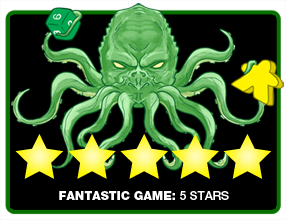 Hits:
Hits:
• I am a sucker for any game that lets me use my cards in variety of ways.
• Any gamer familiar with light-to-medium strategy games should have no problem picking up the rules easily.
• Great artwork on the cards; each location card has so many little fun details added to the images.
Easter egg alert: lift the insert out of the game box and check out one of the hidden insert side panels for a little surprise.
Misses:
• Text on cards is small and hard to read, even when this reviewer is wearing his trusty reading glasses.








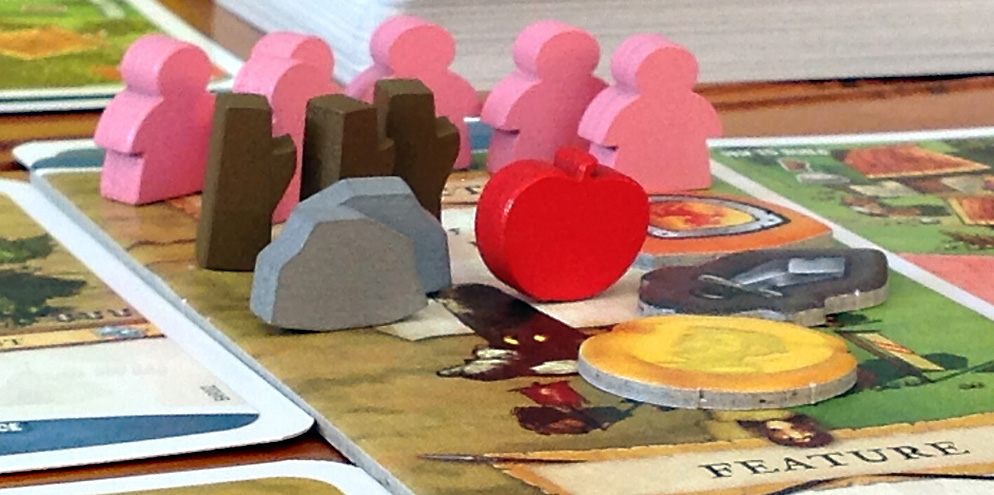

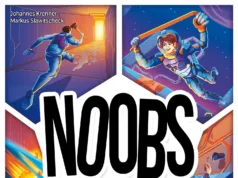













What are the other 2 of your top 3 this year?
I think the other two for me would be Istanbul and Five Tribes.
Very nice review. I like that you pointed out the small text on the cards, as that kind of stuff bothers me. But still…I was on the fence about this game, but you’ve made me want to get it now 🙂
Walt, thank you for the review!
Neuroshima hex author nor chewishek
Not chewishek